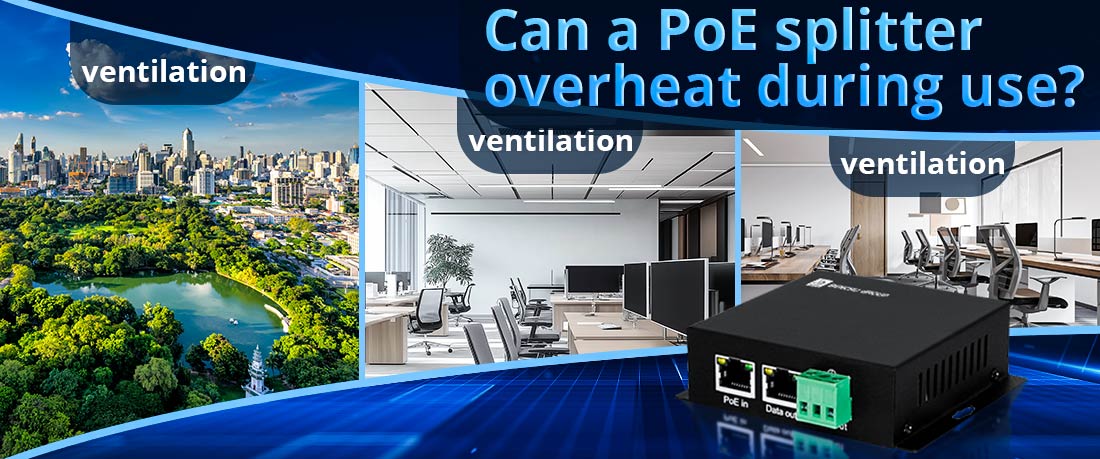
1. Comprendre l'opération de séparation POE
Un séparateur Poe (Power Over Ethernet) extrait la puissance d'un câble Ethernet et le sépare en:
--- Sortie de sortie CC (par exemple, 5V, 9V, 12V ou 24V)
--- Connexion Ethernet des données uniquement
Depuis Poe Splipters Convertir et réguler l'énergie, ils génèrent de la chaleur pendant le fonctionnement. Cependant, dans des conditions normales, un séparateur POE ne doit pas surchauffer s'il est correctement conçu et utilisé dans ses spécifications.
2. Causes de surchauffe de séparateur POE
Si un séparateur POE surchauffe, il peut indiquer un problème lié à la gestion de l'énergie, à la ventilation ou à la qualité des composants. Voici quelques raisons courantes de surchauffe:
A. surcharger le séparateur POE
--- Cause: l'appareil connecté dessine plus d'énergie que le séparateur ne peut en supporter.
--- Effet: un courant excessif provoque des composants internes (régulateurs de tension, transformateurs) en surchauffe.
Solution:
--- Vérifiez la cote de puissance du séparateur POE et assurez-vous qu'elle répond ou dépasse l'exigence de wattage de l'appareil connecté.
--- Utilisez un séparateur POE de plus grande puissance si nécessaire (par exemple, PoE + (802.3AT) ou POE ++ (802.3bt) au lieu de la norme 802.3af).
B. Mauvaise ventilation ou dissipation thermique
--- Cause: le séparateur POE est placé dans un espace serré et fermé avec un mauvais flux d'air.
--- Effet: la chaleur s'accumule, conduisant à une contrainte thermique et à une défaillance potentielle.
Solution:
--- Placez le séparateur dans une zone bien ventilée.
--- Évitez de l'empiler sur des appareils générateurs de chaleur comme les routeurs ou les commutateurs.
C. Composants bon marché ou de faible qualité
--- Cause: les séparateurs POE bon marché peuvent utiliser des régulateurs de tension de faible qualité ou de mauvais matériaux de dissipation thermique.
--- Effet: une mauvaise gestion thermique entraîne un chauffage excessif et une défaillance potentielle.
Solution:
--- Choisissez une marque de confiance et vérifiez les certifications (IEEE 802.3af / AT / BT Conformité).
--- Lisez les critiques pour voir si la surchauffe est un problème courant.
D. Régulation ou efficacité de la conversion insuffisante
--- Cause: les séparateurs PoE décomposent la tension POE (généralement 48 V du câble Ethernet) à une tension inférieure (par exemple, 12V, 9V, 5V). Si l'efficacité de conversion est faible, l'excès de puissance est gaspillé sous forme de chaleur.
--- Effet: perte de puissance plus élevée = plus de chaleur = réduction de la durée de vie.
Solution:
--- Utilisez des séparateurs POE avec des convertisseurs DC-DC à haute efficacité (efficacité de 80% +).
--- Vérifiez les fonctionnalités de refroidissement actives comme les dissipateurs de chaleur.
E. Températures ambiantes élevées
--- Cause: utiliser un séparateur POE dans un environnement chaud (par exemple, à l'extérieur, paramètres industriels, près des sources de chaleur).
--- Effet: l'accumulation de chaleur peut provoquer un arrêt thermique ou une dégradation des composants.
Solution:
--- Utilisez un séparateur POE de qualité industrielle évalué pour des températures élevées.
--- Évitez la lumière directe du soleil ou placez-vous près de l'équipement chaud.
F. Splitter PoE défectueux ou endommagé
--- Cause: un ancien séparateur POE défectueux ou endommagé peut avoir des circuits courts internes ou des composants dégradés.
--- Effet: une résistance accrue provoque une surchauffe et une défaillance potentielle de l'appareil.
Solution:
--- Remplacez le séparateur s'il surchauffe fréquemment ou provoque des problèmes de connectivité.
--- Inspectez les marques de brûlure, le plastique fondu ou les odeurs inhabituelles.
3. Risques de séparateurs Poe surchauffés
Si un séparateur POE surchauffe, il peut conduire à:
--- Échec de l'appareil - La chaleur excessive peut endommager les circuits internes.
--- Efficacité réduite - La surchauffe peut provoquer des chutes de tension ou une puissance instable.
--- Perturbations du réseau - Un séparateur surchauffé peut provoquer des problèmes de connectivité intermittents.
--- Ranger d'incendie (dans les cas extrêmes) - Des séparateurs de mauvaise qualité sans protection thermique peuvent présenter des risques de sécurité.
4. Comment empêcher la surchauffe du séparateur POE
--- Vérifiez les exigences d'alimentation: assurez-vous que le séparateur POE prend en charge le tirage à l'alimentation requis du périphérique connecté.
--- Assurer une bonne ventilation: gardez le séparateur POE dans un espace ouvert avec un bon flux d'air.
--- Utilisez un séparateur POE de haute qualité: choisissez des séparateurs avec des régulateurs de tension à haute efficacité et des caractéristiques de protection thermique.
--- Température du moniteur: si un séparateur POE est trop chaud pour toucher, envisagez de le remplacer ou améliorer la ventilation.
--- Utilisez PoE + ou PoE ++ pour les appareils de haute puissance: si votre appareil a besoin de plus de puissance, passez à PoE + (802.3at) ou PoE ++ (802.3bt) au lieu de pousser un séparateur POE standard au-delà de sa limite.
--- Évitez les longueurs excessives du câble: les câbles longs augmentent la perte de puissance et l'accumulation de chaleur. Utilisez des câbles Cat6A ou Cat7 de haute qualité pour une meilleure efficacité énergétique.
--- Vérifiez les dommages ou les unités défectueuses: si un séparateur POE surchauffe fréquemment, il peut être défectueux. Remplacez-le si nécessaire.
5. Conclusion: un séparateur PoE peut-il surchauffer?
--- Oui, un Séparateur de Poe peut surchauffer s'il est surchargé, mal ventilé ou fabriqué avec des composants de basse qualité.
--- La surchauffe peut provoquer une instabilité de puissance, une défaillance de l'appareil ou même des risques d'incendie dans des cas extrêmes.
--- Choisir un séparateur POE de haute qualité, assurer une bonne ventilation et des besoins en puissance de correspondance peut empêcher la surchauffe.
Si vous remarquez une surchauffe cohérente, il est peut-être temps de remplacer le séparateur POE par un modèle mieux évalué.